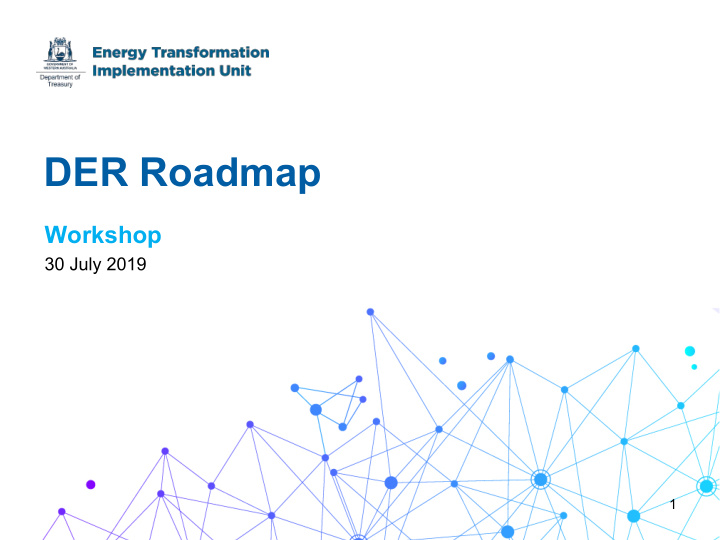



DER Roadmap Workshop 30 July 2019 1
Welcome and Introduction Danny DeSchutter Principal, ThinkPlace 2 Department of Treasury
Opening Remarks Stephen Edwell Independent Chair, Energy Transformation Taskforce 3 Department of Treasury
Setting the Scene on Distributed Energy Resources Jai Thomas DER Project Lead, Energy Transformation Implementation Unit 4 Department of Treasury
DEFINITION OF DER Distributed energy resources can refer to distribution level resources which • produce electricity, or • actively manage consumer demand e.g. solar PV systems, electric vehicles, batteries, and demand response such as hot water systems, pool pumps, smart appliances and air conditioning control 5 Department of Treasury
CONTEXT • AEMO has estimated the minimum demand will breach the system security threshold of 700MW in 2022, and will continue to decrease further over time. 6 Department of Treasury
THE VIEW FROM CARNARVON https://youtu.be/X_1mjYb1yVY Video courtesy of Horizon Power Department of Treasury
WHAT IS THE DER ROADMAP? “An action-oriented plan that seeks to identify the policy, regulatory, customer and technical requirements (and who is accountable for delivering them) to support high levels of DER on the SWIS whilst ensuring safe, secure and affordable electricity supply in the short, medium and long- term.” 8 Department of Treasury
SWIS CHARACTERISTICS • Wholesale, Capacity and Essential Services markets DER currently unable to participate in these markets • • Monopoly, government-owned retailer (Synergy) for small customers Uniform tariff policy – high variable/low fixed charges • Tariffs not aligned with underlying cost structure • • Monopoly, government-owned network operator • Western Power expenditure and revenue is regulated ERA applies efficient expenditure test and ex-post review • Non-network solutions assessed and procured by WP • Reliability measures built into Access Arrangement and • Network Quality and Reliability of Supply Code 9 Department of Treasury
THE VALUE STACK Reliable supply to customers has multiple inputs: Representative Cost Stack 100% Green Schemes, 1% Market Fee & Essential Services, 2% Retail, 3% 90% Energy Cost, 20% 80% 70% 60% Capacity Cost, 25% 50% 40% 30% 20% Network Cost, 49% 10% 10 0% 1 Department of Treasury
DER – THE STATE OF PLAY • 1,100MW installed rooftop solar PV capacity 280,000+ installations in the SWIS • Capacity growing rapidly (~200MW per year) • • Battery uptake has been slow so far 900+ battery installations • Current price not cost effective - downward price trend • • Minimal uptake of Electric Vehicles to date <400 registered in WA (2018) • 0.1% of new passenger vehicle sales • Currently a load – potential for grid support in the long term • • Little-to-no centralised coordination of DERs 11 Department of Treasury
DER ARRANGEMENTS • Inverter standards apply (AS4777.2) • Legacy feed-in tariff (ends 2020-21) • Renewable Energy Buyback Scheme Flat rate - 7.135c/kWh • 5kW limit, no battery export • • Non-REBS DER connections Limited by Western Power’s Connection • Guidelines and technical limits Battery exports allowed • Off-take negotiated with retailers • 12 Department of Treasury
DER PILOTS AND TRIALS • Distribution Battery Storage Western Power/Synergy • • DER control and optimisation trials Horizon Power: Broome, Carnarvon, Onslow • • Network technical trials Western Power: dynamic tap changes • • Pricing Trials Horizon Power MyPower • • Peer to Peer trading trials 13 Department of Treasury
WHAT’S GOING ON ELSEWHERE • Open Energy Networks program defining Distribution System Operator roles “Coordination of these distributed resources is essential to alleviate the challenges and convert what could otherwise be a challenge to the system into an asset” AEMO and Energy Networks Australia 2018, Open Energy Networks, Consultation Paper 14 Department of Treasury
LOOKING AHEAD • What are the key ingredients to the future state we need to support a high-DER future? • What market, technical, customer and regulatory settings are required to get us there, that don’t exist today? • Are there any major barriers? • Which actions should be prioritised? 15 Department of Treasury
THE BASELINE SCENARIO • Continuation of current trends over next 5 years to 2025. • High PV uptake • Passive DER • Low day-time demand from the grid • System security and reliability issues have emerged • Network hosting capacity becoming an issue • Battery uptake growth steady • Electric Vehicle growth remains low • Utility-scale renewables growth steady • Hydrogen adoption extremely limited • The DER Roadmap will define actions required over the next 5 years 16 Department of Treasury
CREATING THE ALTERNATIVE SCENARIO • Maintaining system security and reliability • Unlocking value of DER • Customers’ continued ability to connect DER 17 Department of Treasury
DOMAINS Domain •Technology •Network Solutions and Investments •Network operations •Regulations and Rules •Tariffs and incentives •Markets •Customer protections 18 Department of Treasury
Next steps Engagement: – Consolidation and review of todays findings – 1:1 sessions with Stakeholders – please reach out – Future sessions on specific topics as required Contact details Jai Thomas DER Project Lead, Energy Transformation Implementation unit jai.thomas@treasury.wa.gov.au For further information, please visit our webpage: http://www.treasury.wa.gov.au/Energy-Transformation/ 19 Department of Treasury
Recommend
More recommend